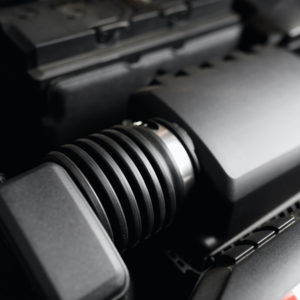Trouble codes help alert drivers to potential issues in their vehicles. For many, dealing with trouble codes can sound like an intimidating task. If this is your first time encountering the P2185 code on your scan tool, this brief guide can help you learn more about its definition, common causes, and symptoms.
What Does the P2185 Code Mean?
Diagnostic trouble code (DTC) P2185 stands for “Engine Coolant Temperature Sensor 2 Circuit High.” This code sets when the powertrain control module (PCM) detects an electrical fault in the engine coolant temperature (ECT) circuit.

The ECT sensor is a thermistor that’s responsible for measuring the temperature of the coolant going through the engine. It’s typically located in a coolant passage in the cylinder head. This sensor’s resistance is high when the coolant temperature is low and its resistance is low when the coolant temperature is high.
The PCM monitors the voltage changes from the ECT sensor to determine the coolant’s temperature. If the ECT reads less than the expected temperature when the engine has been running for more than a few minutes, the PCM determines a fault and sets the P2185. The PCM can also set this code if the ECT sensor’s resistance does not match the expected values.

Note: The definition of code P2185 can be different depending on the vehicle manufacturer. Consult the appropriate repair manual or repair database for the exact code definition.
What are the Common Causes of the P2185 Code?
Trouble codes like the P2185 can have multiple possible causes. Here are some of the possible issues that can trigger the P2185 code:
- ECT sensor malfunction
- PCM failure
- Bad connection in the #2 ECT sensor
- Open in the ground circuit between #2 ECT sensor and PCM
- Short in the voltage feed between the ECT sensor and PCM
- PCM failure (uncommon)
- Other wiring issues

What are the Common Symptoms of the P2185 Code?
When it comes to trouble codes, you might notice a number of different symptoms or none at all. here are some of the common symptoms you might spot if you’re dealing with the OBD-II code P2185:
- Illuminated malfunction indicator lamp or check engine light
- A/C might not operate
- Decreased engine performance
- Increased fuel consumption
- Potential no start condition
How to Diagnose the P2185 Code
Different DTCs can share causes and symptoms. This is why it’s important to thoroughly diagnose the issue before making any repairs or replacing any parts.
Fortunately, there are many auto repair resources and guides available today. These can help you learn more about trouble codes, their definition, and how to repair them.
If you want to know more about the P2185 code and how to troubleshooting and repair the issues that are triggering it, these videos can be very helpful:
How to Fix the P2185 Code
Fixing DTCs is a complex process. Different codes can have similar causes, and each of these potential causes have different solutions. Vehicle manufacturers also have their own recommended repair procedures. The solution to the P2185 code in a Honda can’t fix the same code in a Volkswagen. There’s simply no magic bullet fixes for DTCs.
It takes special tools and expertise to diagnose and fix DTCs properly. If you’re not confident in your DTC repair skills, it’s best to leave the job to a certified mechanic so you can avoid costly repairs down the line.
Other Notes About P2185
The P2185 is identical to the P0118. The only difference between these two codes is that the OBD-II code P2185 refers to the #2 ECT sensor circuit. This means that vehicles that have the P2185 code have two ECT sensors. When dealing with the P2185, make sure to diagnose and repair the correct sensor circuit.
Plugging your OBD-II scanner into your vehicle’s OBD-II port allows you to view DTCs that are currently registered. If you encounter the P2185 code or other related codes, it’s highly recommended that you stop driving your vehicle and take it to a repair shop for diagnosis and repairs as soon as possible.
Any information provided on this Website is for informational purposes only and is not intended to replace consultation with a professional mechanic. The accuracy and timeliness of the information may change from the time of publication.


















